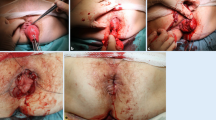Abstract
Purpose
Data comparing surgical outcomes and quality of life (QOL) following perineal repair of rectal prolapse are limited. The aim of our study was to compare the short-term outcome and QOL of two perineal procedures in patients with rectal prolapse.
Methods
All patients with full-thickness rectal prolapse admitted to our institution and undergoing Delorme and Altemeier procedures from 2005 to 2013 were identified using an institutional, IRB-approved rectal prolapse database. Short-term outcomes and QOL were compared.
Results
Seventy-five patients (93 % female) underwent rectal prolapse surgery: 22 Altemeier and 53 Delorme, mean age 72 ± 15 years. Sixty-six percentage of patients were ASA grade III or IV (Table 1). The median hospital stay was longer in Altemeier’s group [4 (1–44) days vs. 3 (0–14) days; p = 0.01]. After a median follow-up of 13 (1–88) months, the rate of recurrent prolapse was 14 % (n = 11) [Altemeier 2 (9 %) vs. Delorme 9 (16 %) p = 0.071]. Postoperative complication rate was 12 % (n = 9) [Altemeier 5 (22 %) vs. Delorme 4 (7 %), p = 0.04]. There was no mortality. The Cleveland Global Quality of Life scores in each group were 0.6 ± 0.2 and 0.5 ± 0.3, respectively (p = 0.59), and were not changed by the surgery.
Conclusions
In patients where abdominal repair of rectal prolapse is judged to be unwise, a Delorme procedure offers short-term control of the prolapse with low risk of complications and with reasonable function. In addition, patients that recur after a Delorme procedure can undergo another similar transanal procedure without compromising the vascular supply of the rectum.

Similar content being viewed by others
References
Brown AJ, Anderson JH, McKee RF, Finlay IG (2004) Strategy for selection of type of operation for rectal prolapse based on clinical criteria. Dis Colon Rectum 47:103–107
Madiba T, Baig M, Wexner S (2005) Surgical management of rectal prolapse. Arch Surg 140:63–73
Altemeier WA, Culbertson WR, Schowengerdt C, Hunt J (1971) Nineteen years’ experience with the one-stage perineal repair of rectal prolapse. Ann Surg 173:993–1006
Kim DS, Tsang CB, Wong WD, Lowry AC, Goldberg SM, Madoff RD (1999) Complete rectal prolapse: evolution of management and results. Dis Colon Rectum 42:460–466
Zbar AP, Takashima S, Hasegawa T, Kitabayashi K (2002) Perineal rectosigmoidectomy (Altemeir procedure): a review of physiology technique and outcome. Tech Coloproctol 6:109–116
Riansuwan W, Hull TL, Bast J, Hammel JP, Church JM (2010) Comparison of perineal operations with abdominal operations for full-thickness rectal prolapse. World J Surg 34:1116–1122
Schoetz DJ (2006) Evolving practice patterns in colon and rectal surgery. J Am Coll Surg 203:322–327
Varma MG, Wang JY, Berian JR, Patterson TR, McCrea GL, Hart SL (2008) The constipation severity instrument: a validated measure. Dis Colon Rectum 51:162–172
Rockwood TH, Church JM, Fleshman JW et al (2000) Fecal Incontinence Quality of Life Scale: quality of life instrument for patients with fecal incontinence. Dis Colon Rectum 43:9–16
Fazio VW, O’Riordain MG, Lavery IC et al (1999) Long-term functional outcome and quality of life after stapled restorative proctocolectomy. Ann Surg 230:575–586
Agachan F, Reissman P, Pfeifer J, Weiss EG, Nogueras JJ, Wexner SD (1997) Comparison of three perineal procedures for the treatment of rectal prolapse. South Med J 90:925–932
Kimmins MH, Evetts BK, Isler J, Billingham R (2001) The Altemeier repair: outpatient treatment of rectal prolapse. Dis Colon Rectum 44:565–570
Senapati A, Gray R, Middleton L et al (2013) PROSPER: a randomized comparison of surgical treatments for rectal prolapse. Colorectal Dis 15:858–870
Acknowledgments
Poster presentation at the annual meeting of the American Society of Colon and Rectal Surgeons, Hollywood, Florida, May 17–21, 2014.
Conflict of interest
None.
Ethical approval
All procedures performed in studies involving human participants were in accordance with ethical standards of, Cleveland Clinic Foundation, Cleveland, Ohio, USA.
Informed consent
A waiver of consent was obtained from the Institutional Review Board.
Author information
Authors and Affiliations
Corresponding author
Rights and permissions
About this article
Cite this article
Elagili, F., Gurland, B., Liu, X. et al. Comparing perineal repairs for rectal prolapse: Delorme versus Altemeier. Tech Coloproctol 19, 521–525 (2015). https://doi.org/10.1007/s10151-015-1337-y
Received:
Accepted:
Published:
Issue Date:
DOI: https://doi.org/10.1007/s10151-015-1337-y




